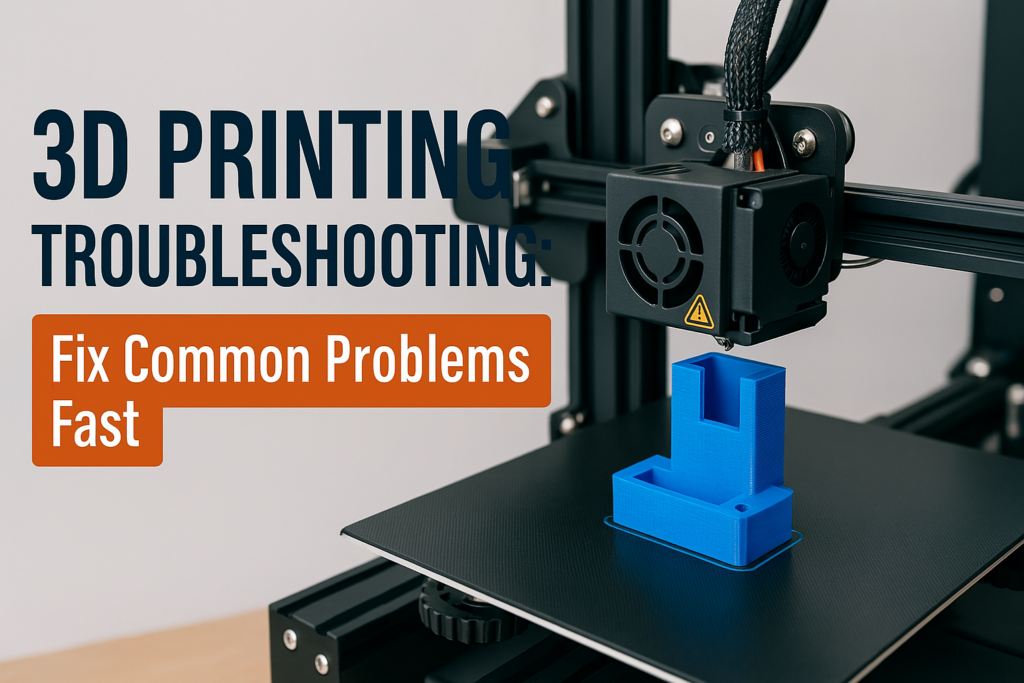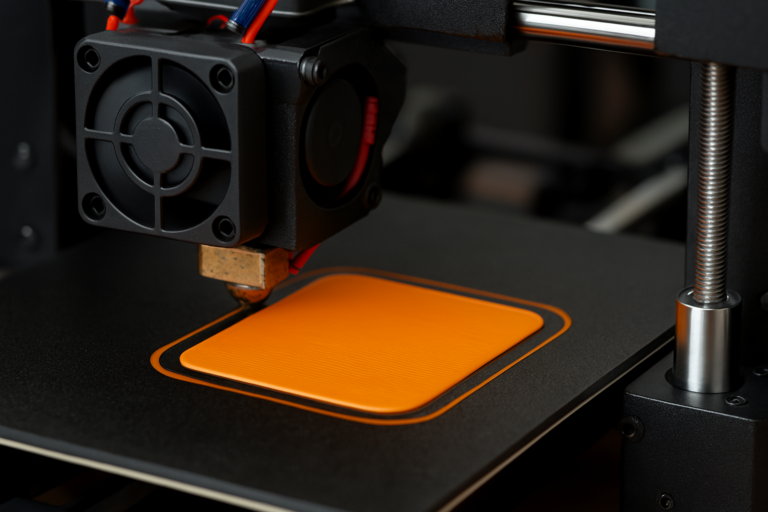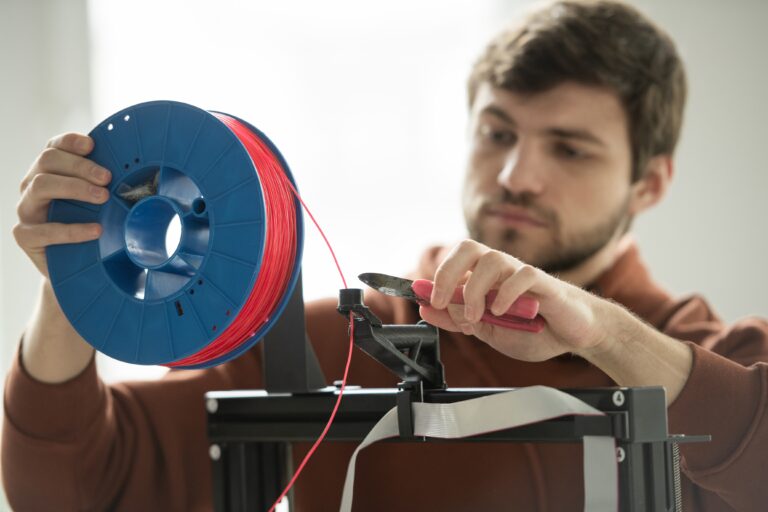3D printing can be a fantastic and rewarding hobby, but it’s not without its challenges. If you are facing issues with stringing, layer separation, warping, or other common 3D printing problems, don’t worry! This post will guide you through troubleshooting these common issues. Each section includes visual cues to help you identify the problem, explores potential causes, and offers a step-by-step solution in an easy-to-follow format. Let’s get started!
1. Stringing
Visual Cues:
- Fine threads of filament connecting different parts of the print.
- Spaghetti-like strands across non-contact areas.
Causes:
- High temperature during printing.
- Poor retraction settings.
- Humidity in filament.
Solution Steps:
- Lower the nozzle temperature: Start by decreasing it by 5-10 degrees Celsius.
- Enable retraction: Make sure your slicer settings have retraction enabled.
- Adjust retraction distance and speed: Try increasing the distance and speed based on your printer’s specifications.
- Dry your filament: Store filament in a dry place or use a filament dryer to remove excess moisture.
2. Layer Separation
Visual Cues:
- Visible gaps between layers.
- Weak, flimsy parts that can be easily broken.
Causes:
- Inadequate extrusion.
- Poor layer adhesion due to temperature issues.
- Incorrect print speed.
Solution Steps:
- Increase print temperature: Raise the nozzle temperature by 5-10 degrees.
- Slow down print speed: Reduce the print speed to allow for better layer bonding.
- Ensure proper extrusion: Calibrate your extruder to verify accurate filament feed.
3. Warping
Visual Cues:
- Corners of the print lifting from the bed.
- Uneven base or edges curling up.
Causes:
- Insufficient bed adhesion.
- Rapid cooling of printed material.
- Incorrect bed temperature.
Solution Steps:
- Increase bed temperature: Ensure that the bed temperature matches the filament type (e.g., 60°C for PLA).
- Use a proper bed adhesive: Apply a glue stick, hairspray, or specific 3D printing adhesive for better adhesion.
- Consider an enclosure: An enclosure helps maintain a consistent temperature around the print, reducing warping.
4. Under-extrusion
Visual Cues:
- Thin or missing lines in prints.
- Gaps or holes in surfaces.
Causes:
- Clogged nozzle.
- Insufficient filament supply.
- Incorrect extrusion settings.
Solution Steps:
- Check for clogs: Clean the nozzle by performing a cold pull or replacing it if necessary.
- Calibrate the extruder: Adjust the extruder steps-per-mm settings in your firmware.
- Increase the extrusion multiplier: Adjust this in your slicer settings incrementally until you achieve even prints.
5. Over-extrusion
Visual Cues:
- Blobs or zits on prints.
- Excess material in corners or overhangs.
Causes:
- Incorrect extrusion settings.
- Inconsistent filament diameter.
Solution Steps:
- Calibrate your extruder: As with under-extrusion, ensure your steps-per-mm settings are correct.
- Decrease the extrusion multiplier: Adjust this in your slicer settings to reduce filament flow.
- Check filament quality: Make sure your filament diameter matches your slicer settings.
6. Blobs and Zits
Visual Cues:
- Small lumps or bump formations on printed surfaces.
Causes:
- Inconsistent retraction.
- Abrupt changes in print direction.
- Over-extrusion.
Solution Steps:
- Adjust retraction settings: Experiment with retraction distance and speed to minimize blobs.
- Reduce acceleration and jerk settings: Smooth out changes during printing for better results.
- Check for loose components: Tighten any loose parts of the printer that might affect print quality.
7. Skeinforge Printing Issues
Visual Cues:
- Inconsistent gaps or overlapping lines.
Causes:
- Incorrect slicer settings.
- Base layer speed is too fast.
Solution Steps:
- Revisit slicer settings: Ensure the layer height and speed settings are balanced for your printer.
- Set a slower initial layer speed: This allows for better adhesion and layer consistency.
- Choose a different slicer: If issues persist, consider trying a newer or more updated slicer that may handle your printer’s profile better.
8. Nozzle Clogs
Visual Cues:
- Filament not flowing from the nozzle.
- Unusual noise from the extruder motor.
Causes:
- Burnt filament inside the nozzle.
- Dust and debris accumulation.
Solution Steps:
- Perform a cold pull: Heat the nozzle, then cool it briefly before pulling out any filament to clean it.
- Replace the nozzle: If blockage persists, replacing the nozzle may be necessary.
- Regular maintenance: Keep your printer clean to reduce debris build-up.
9. Bed Adhesion Problems
Visual Cues:
- Prints lifting off or shifting during printing.
Causes:
- Uneven bed surface.
- Incorrect bed temperature.
Solution Steps:
- Level the bed: Use a feeler gauge or a piece of paper to ensure your bed is level.
- Increase bed temperature: Experiment with the bed temperature suited to your filament.
- Utilize adhesion aids: Add a layer of glue stick or specialized surface materials.
10. Layer Misalignment
Visual Cues:
- Visible offsets between layers resulting in a stair-step effect.
Causes:
- Loose belts or couplings.
- Poor stepper motor calibration.
Solution Steps:
- Check and tighten belts: Ensure that the belts for the X and Y axes are secure.
- Calibrate stepper motors: Adjust motor steps-per-mm settings if needed.
- Assess the frame: Ensure the printer frame is sturdy and does not wobble during printing.
11. Overheating Components
Visual Cues:
- Failed prints with melted plastic or sizzling sounds.
Causes:
- Too high a print temperature.
- Failed cooling fans.
Solution Steps:
- Lower the print temperature: Adjust settings as needed for specific materials.
- Inspect cooling fans: Check that all cooling fans are operational and not obstructed.
- Add additional cooling: Use part cooling fans to help maintain temperature control.
12. Ghosting or Ringing
Visual Cues:
- Echo-like lines around printed features.
Causes:
- High print speed.
- Loose belts.
Solution Steps:
- Reduce print speed: Lower speed settings to minimize vibrations.
- Tighten belts: Inspect and tighten any loose components that may contribute to the problem.
- Adjust acceleration settings: Lower acceleration in slicer settings to prevent vibrations during fast movements.
With this troubleshooting guide, you can diagnose and fix the most common 3D printing problems quickly. Remember to take careful notes of any adjustments you make, as understanding your printer’s responses will help you improve your craft over time. Happy printing!



